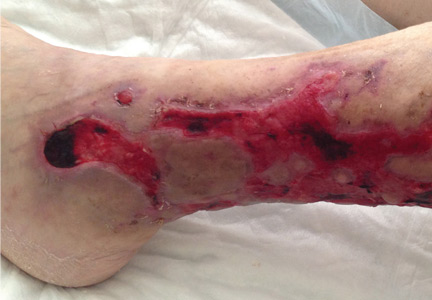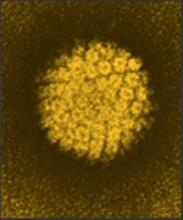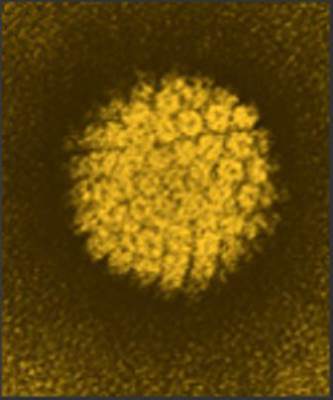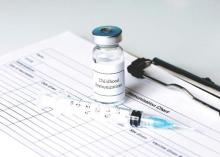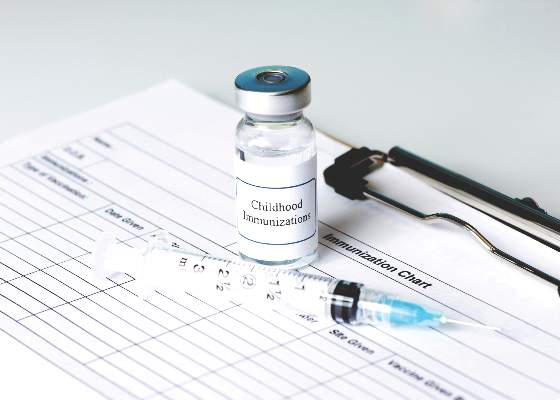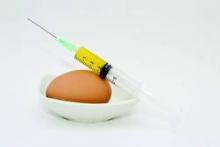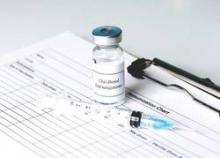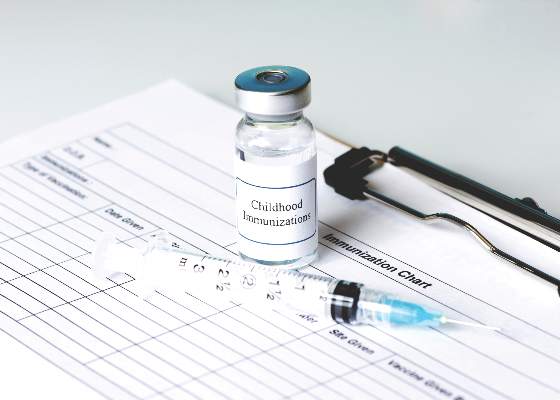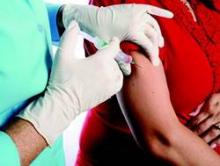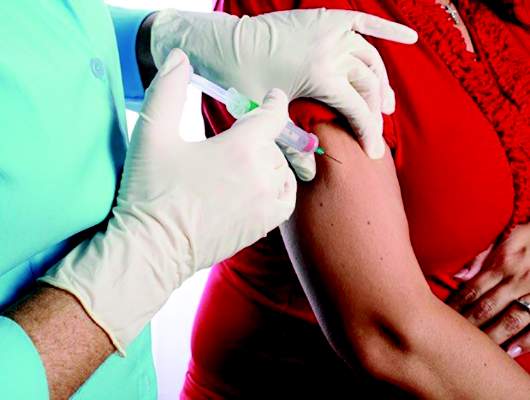User login
Stellate ulceration in a nonuremic patient
A 64-year-old man was admitted for extensive painful ulceration of the left lower leg (Figure 1) that occurred after a fall and that had worsened over the last 4 months.
His medical history included hyperuricemia, hypertension, and type 2 diabetes mellitus. He had no known cardiac or renal disease.
Results of initial laboratory testing showed the following:
- Hemoglobin 10.9 g/dL (reference range 13.5–17.5); red blood cells were normocytic and normochromic
- White blood cell count 10.2 × 109/L (4.5–11.0)
- Neutrophil count 9.11 × 109/L (2.0–8.5)
- C-reactive protein 259 mg/L (< 5)
- Creatinine, urea, sodium, potassium, calcium, and phosphate were within normal limits.
Doppler ultrasonography of the legs showed mild diffuse atheromatous arterial disease without significant blockage of blood flow, in addition to mild bilateral venous insufficiency.
Cutaneous biopsy showed intravascular calcium deposition in the hypodermis (Figure 2) and reticular dermis, erythrocyte extravasation in the superficial dermis, and epidermal necrosis, thus establishing the diagnosis of nonuremic calciphylaxis. The vascular occlusion with spreading necrosis gave the characteristic stellate appearance.
Aside from diabetes, our patient had none of the conditions usually associated with nonuremic calciphylaxis—namely, hyperparathyroidism, previous corticosteroid therapy, warfarin use, connective tissue disease, or malignancy.
A POORLY UNDERSTOOD SMALL-VESSEL VASCULOPATHY
Calciphylaxis is a poorly understood small-vessel vasculopathy, most often associated with end-stage renal disease, with a prevalence of 1% to 4% in patients on dialysis.1 It carries a high risk of death, most often from sepsis.
The cause is still unclear, but several conditions have been implicated, including primary hyperparathyroidism, malignancies, alcoholic liver disease, connective tissue disease, and diabetes.2
Making the diagnosis may be challenging, especially in nonuremic patients. It is a rare condition, the presentation is not always typical, and it can occur with fully normal kidney function and normal indicators of calcium and phosphate metabolism.
The differential diagnosis includes:
- Vasculitis, either primary or secondary to an autoimmune disorder such as rheumatoid arthritis, systemic lupus erythematosus, or cryoglobulinemia
- Peripheral vascular disease
- Other inflammatory conditions such as pyoderma gangrenosum and panniculitis
- Infections such as cellulitis and necrotizing fasciitis
- Iatrogenic disorders such as warfarin necrosis and early-stage nephrogenic systemic fibrosis.3,4
The current approach to treatment is multidisciplinary and is based only on case reports and small case series, since no randomized prospective trial has been done. The goal is optimal control of calcium and phosphate homeostasis and correction of hypercoagulability.5 Available data4,5 support appropriate wound care and surgical debridement.4,5 Intravenous sodium thiosulfate is the most widely used medical treatment and can be given regardless of the level of renal function. Resolution rates have been greater than 90% in patients with normal renal function, whereas improvement in cutaneous ulcers and pain has been observed in 70% of hemodialysis patients.4 However, it does not reduce the associated mortality rate.4
Awareness of nonuremic calciphylaxis and a high index of suspicion are needed when any patient presents with a leg ulcer and no clear cause. It should be considered in the differential diagnosis of leg ulcer in patients with chronic renal failure even if they have risk factors for more common causes of ulcers, and even occasionally in patients such as ours without chronic kidney disease or other risk factors for this condition.
OUR PATIENT’S MANAGEMENT
The patient developed profuse diarrhea, and infection with Clostridium difficile was confirmed. Despite treatment with metronidazole and vancomycin, he died several days later. No treatment directed to calciphylaxis was ever started because of the patient’s unstable condition during the entire hospitalization.
- Van Hattem S, Bootsma AH, Thio HB. Skin manifestations of diabetes. Cleve Clin J Med 2008; 75:772–777.
- Nigwekar SU, Wolf M, Sterns RH, Hix JK. Calciphylaxis from nonuremic causes: a systematic review. Clin J Am Soc Nephrol 2008; 3:1139–1143.
- Lee JL, Naguwa SM, Cheema G, Gershwin ME. Recognizing calcific uremic arteriolopathy in autoimmune disease: An emerging mimicker of vasculitis. Autoimmun Rev 2008; 7:638–643.
- Wollina U. Update on cutaneous calciphylaxis. Indian J Dermatol 2013; 58:87–92.
- Ross EA. Evolution of treatment strategies for calciphylaxis. Am J Nephrol 2011; 34:460–467.
A 64-year-old man was admitted for extensive painful ulceration of the left lower leg (Figure 1) that occurred after a fall and that had worsened over the last 4 months.
His medical history included hyperuricemia, hypertension, and type 2 diabetes mellitus. He had no known cardiac or renal disease.
Results of initial laboratory testing showed the following:
- Hemoglobin 10.9 g/dL (reference range 13.5–17.5); red blood cells were normocytic and normochromic
- White blood cell count 10.2 × 109/L (4.5–11.0)
- Neutrophil count 9.11 × 109/L (2.0–8.5)
- C-reactive protein 259 mg/L (< 5)
- Creatinine, urea, sodium, potassium, calcium, and phosphate were within normal limits.
Doppler ultrasonography of the legs showed mild diffuse atheromatous arterial disease without significant blockage of blood flow, in addition to mild bilateral venous insufficiency.
Cutaneous biopsy showed intravascular calcium deposition in the hypodermis (Figure 2) and reticular dermis, erythrocyte extravasation in the superficial dermis, and epidermal necrosis, thus establishing the diagnosis of nonuremic calciphylaxis. The vascular occlusion with spreading necrosis gave the characteristic stellate appearance.
Aside from diabetes, our patient had none of the conditions usually associated with nonuremic calciphylaxis—namely, hyperparathyroidism, previous corticosteroid therapy, warfarin use, connective tissue disease, or malignancy.
A POORLY UNDERSTOOD SMALL-VESSEL VASCULOPATHY
Calciphylaxis is a poorly understood small-vessel vasculopathy, most often associated with end-stage renal disease, with a prevalence of 1% to 4% in patients on dialysis.1 It carries a high risk of death, most often from sepsis.
The cause is still unclear, but several conditions have been implicated, including primary hyperparathyroidism, malignancies, alcoholic liver disease, connective tissue disease, and diabetes.2
Making the diagnosis may be challenging, especially in nonuremic patients. It is a rare condition, the presentation is not always typical, and it can occur with fully normal kidney function and normal indicators of calcium and phosphate metabolism.
The differential diagnosis includes:
- Vasculitis, either primary or secondary to an autoimmune disorder such as rheumatoid arthritis, systemic lupus erythematosus, or cryoglobulinemia
- Peripheral vascular disease
- Other inflammatory conditions such as pyoderma gangrenosum and panniculitis
- Infections such as cellulitis and necrotizing fasciitis
- Iatrogenic disorders such as warfarin necrosis and early-stage nephrogenic systemic fibrosis.3,4
The current approach to treatment is multidisciplinary and is based only on case reports and small case series, since no randomized prospective trial has been done. The goal is optimal control of calcium and phosphate homeostasis and correction of hypercoagulability.5 Available data4,5 support appropriate wound care and surgical debridement.4,5 Intravenous sodium thiosulfate is the most widely used medical treatment and can be given regardless of the level of renal function. Resolution rates have been greater than 90% in patients with normal renal function, whereas improvement in cutaneous ulcers and pain has been observed in 70% of hemodialysis patients.4 However, it does not reduce the associated mortality rate.4
Awareness of nonuremic calciphylaxis and a high index of suspicion are needed when any patient presents with a leg ulcer and no clear cause. It should be considered in the differential diagnosis of leg ulcer in patients with chronic renal failure even if they have risk factors for more common causes of ulcers, and even occasionally in patients such as ours without chronic kidney disease or other risk factors for this condition.
OUR PATIENT’S MANAGEMENT
The patient developed profuse diarrhea, and infection with Clostridium difficile was confirmed. Despite treatment with metronidazole and vancomycin, he died several days later. No treatment directed to calciphylaxis was ever started because of the patient’s unstable condition during the entire hospitalization.
A 64-year-old man was admitted for extensive painful ulceration of the left lower leg (Figure 1) that occurred after a fall and that had worsened over the last 4 months.
His medical history included hyperuricemia, hypertension, and type 2 diabetes mellitus. He had no known cardiac or renal disease.
Results of initial laboratory testing showed the following:
- Hemoglobin 10.9 g/dL (reference range 13.5–17.5); red blood cells were normocytic and normochromic
- White blood cell count 10.2 × 109/L (4.5–11.0)
- Neutrophil count 9.11 × 109/L (2.0–8.5)
- C-reactive protein 259 mg/L (< 5)
- Creatinine, urea, sodium, potassium, calcium, and phosphate were within normal limits.
Doppler ultrasonography of the legs showed mild diffuse atheromatous arterial disease without significant blockage of blood flow, in addition to mild bilateral venous insufficiency.
Cutaneous biopsy showed intravascular calcium deposition in the hypodermis (Figure 2) and reticular dermis, erythrocyte extravasation in the superficial dermis, and epidermal necrosis, thus establishing the diagnosis of nonuremic calciphylaxis. The vascular occlusion with spreading necrosis gave the characteristic stellate appearance.
Aside from diabetes, our patient had none of the conditions usually associated with nonuremic calciphylaxis—namely, hyperparathyroidism, previous corticosteroid therapy, warfarin use, connective tissue disease, or malignancy.
A POORLY UNDERSTOOD SMALL-VESSEL VASCULOPATHY
Calciphylaxis is a poorly understood small-vessel vasculopathy, most often associated with end-stage renal disease, with a prevalence of 1% to 4% in patients on dialysis.1 It carries a high risk of death, most often from sepsis.
The cause is still unclear, but several conditions have been implicated, including primary hyperparathyroidism, malignancies, alcoholic liver disease, connective tissue disease, and diabetes.2
Making the diagnosis may be challenging, especially in nonuremic patients. It is a rare condition, the presentation is not always typical, and it can occur with fully normal kidney function and normal indicators of calcium and phosphate metabolism.
The differential diagnosis includes:
- Vasculitis, either primary or secondary to an autoimmune disorder such as rheumatoid arthritis, systemic lupus erythematosus, or cryoglobulinemia
- Peripheral vascular disease
- Other inflammatory conditions such as pyoderma gangrenosum and panniculitis
- Infections such as cellulitis and necrotizing fasciitis
- Iatrogenic disorders such as warfarin necrosis and early-stage nephrogenic systemic fibrosis.3,4
The current approach to treatment is multidisciplinary and is based only on case reports and small case series, since no randomized prospective trial has been done. The goal is optimal control of calcium and phosphate homeostasis and correction of hypercoagulability.5 Available data4,5 support appropriate wound care and surgical debridement.4,5 Intravenous sodium thiosulfate is the most widely used medical treatment and can be given regardless of the level of renal function. Resolution rates have been greater than 90% in patients with normal renal function, whereas improvement in cutaneous ulcers and pain has been observed in 70% of hemodialysis patients.4 However, it does not reduce the associated mortality rate.4
Awareness of nonuremic calciphylaxis and a high index of suspicion are needed when any patient presents with a leg ulcer and no clear cause. It should be considered in the differential diagnosis of leg ulcer in patients with chronic renal failure even if they have risk factors for more common causes of ulcers, and even occasionally in patients such as ours without chronic kidney disease or other risk factors for this condition.
OUR PATIENT’S MANAGEMENT
The patient developed profuse diarrhea, and infection with Clostridium difficile was confirmed. Despite treatment with metronidazole and vancomycin, he died several days later. No treatment directed to calciphylaxis was ever started because of the patient’s unstable condition during the entire hospitalization.
- Van Hattem S, Bootsma AH, Thio HB. Skin manifestations of diabetes. Cleve Clin J Med 2008; 75:772–777.
- Nigwekar SU, Wolf M, Sterns RH, Hix JK. Calciphylaxis from nonuremic causes: a systematic review. Clin J Am Soc Nephrol 2008; 3:1139–1143.
- Lee JL, Naguwa SM, Cheema G, Gershwin ME. Recognizing calcific uremic arteriolopathy in autoimmune disease: An emerging mimicker of vasculitis. Autoimmun Rev 2008; 7:638–643.
- Wollina U. Update on cutaneous calciphylaxis. Indian J Dermatol 2013; 58:87–92.
- Ross EA. Evolution of treatment strategies for calciphylaxis. Am J Nephrol 2011; 34:460–467.
- Van Hattem S, Bootsma AH, Thio HB. Skin manifestations of diabetes. Cleve Clin J Med 2008; 75:772–777.
- Nigwekar SU, Wolf M, Sterns RH, Hix JK. Calciphylaxis from nonuremic causes: a systematic review. Clin J Am Soc Nephrol 2008; 3:1139–1143.
- Lee JL, Naguwa SM, Cheema G, Gershwin ME. Recognizing calcific uremic arteriolopathy in autoimmune disease: An emerging mimicker of vasculitis. Autoimmun Rev 2008; 7:638–643.
- Wollina U. Update on cutaneous calciphylaxis. Indian J Dermatol 2013; 58:87–92.
- Ross EA. Evolution of treatment strategies for calciphylaxis. Am J Nephrol 2011; 34:460–467.
HPV Vaccine Uptake Rising, But Still Low for Male Teens
About one-third of male teens in the United States reported receiving at least one dose of human papillomavirus vaccine, and only 13.9% received a complete series of three doses of the vaccine, although coverage among male adolescents significantly increased from 2010 to 2013, a study showed.*
Dr. Peng-jun Lu of the Centers for Disease Control and Prevention and his associates used data from the 2013 National Immunization Survey–Teen, a national, random-digit-dial telephone survey sponsored by the CDC, to gather information from 6,039 adolescents between the ages of 13 and 17 years. They found coverage of greater than or equal to one dose was significantly higher among non-Hispanic blacks (42.2%) and Hispanics (49.6%), compared with non-Hispanic whites (26.7%). Similarly, human papillomavirus (HPV) vaccination coverage of three or more doses was significantly higher among non-Hispanic blacks (15.7%) and Hispanics (20.3%), compared with non-Hispanic whites (11.1%).
Parents who did not have their sons receive any HPV vaccinations commonly thought that the provider did not recommend them (24.0%), believed that the vaccinations were not needed or not necessary (18.9%), and had a general lack of knowledge (16.4%), the authors reported.
“To further increase HPV vaccination coverage … efforts should be directed to provide comprehensive, accessible, and appropriate communication messages on HPV and HPV vaccine directed to male adolescents and parents,” the researchers concluded.
Read the full article in Pediatrics (doi: 10.1542/peds.2015-1631).
*Correction, 11/4/2015: An earlier version of this story misstated the number of doses of the vaccine received by the study participants. A total of 34.6% reported receiving at least one dose.
About one-third of male teens in the United States reported receiving at least one dose of human papillomavirus vaccine, and only 13.9% received a complete series of three doses of the vaccine, although coverage among male adolescents significantly increased from 2010 to 2013, a study showed.*
Dr. Peng-jun Lu of the Centers for Disease Control and Prevention and his associates used data from the 2013 National Immunization Survey–Teen, a national, random-digit-dial telephone survey sponsored by the CDC, to gather information from 6,039 adolescents between the ages of 13 and 17 years. They found coverage of greater than or equal to one dose was significantly higher among non-Hispanic blacks (42.2%) and Hispanics (49.6%), compared with non-Hispanic whites (26.7%). Similarly, human papillomavirus (HPV) vaccination coverage of three or more doses was significantly higher among non-Hispanic blacks (15.7%) and Hispanics (20.3%), compared with non-Hispanic whites (11.1%).
Parents who did not have their sons receive any HPV vaccinations commonly thought that the provider did not recommend them (24.0%), believed that the vaccinations were not needed or not necessary (18.9%), and had a general lack of knowledge (16.4%), the authors reported.
“To further increase HPV vaccination coverage … efforts should be directed to provide comprehensive, accessible, and appropriate communication messages on HPV and HPV vaccine directed to male adolescents and parents,” the researchers concluded.
Read the full article in Pediatrics (doi: 10.1542/peds.2015-1631).
*Correction, 11/4/2015: An earlier version of this story misstated the number of doses of the vaccine received by the study participants. A total of 34.6% reported receiving at least one dose.
About one-third of male teens in the United States reported receiving at least one dose of human papillomavirus vaccine, and only 13.9% received a complete series of three doses of the vaccine, although coverage among male adolescents significantly increased from 2010 to 2013, a study showed.*
Dr. Peng-jun Lu of the Centers for Disease Control and Prevention and his associates used data from the 2013 National Immunization Survey–Teen, a national, random-digit-dial telephone survey sponsored by the CDC, to gather information from 6,039 adolescents between the ages of 13 and 17 years. They found coverage of greater than or equal to one dose was significantly higher among non-Hispanic blacks (42.2%) and Hispanics (49.6%), compared with non-Hispanic whites (26.7%). Similarly, human papillomavirus (HPV) vaccination coverage of three or more doses was significantly higher among non-Hispanic blacks (15.7%) and Hispanics (20.3%), compared with non-Hispanic whites (11.1%).
Parents who did not have their sons receive any HPV vaccinations commonly thought that the provider did not recommend them (24.0%), believed that the vaccinations were not needed or not necessary (18.9%), and had a general lack of knowledge (16.4%), the authors reported.
“To further increase HPV vaccination coverage … efforts should be directed to provide comprehensive, accessible, and appropriate communication messages on HPV and HPV vaccine directed to male adolescents and parents,” the researchers concluded.
Read the full article in Pediatrics (doi: 10.1542/peds.2015-1631).
*Correction, 11/4/2015: An earlier version of this story misstated the number of doses of the vaccine received by the study participants. A total of 34.6% reported receiving at least one dose.
FROM PEDIATRICS
EADV: Another promising topical for atopic dermatitis
COPENHAGEN – A novel topical nonsteroidal inhibitor of phosphodiesterase-4 showed a favorable efficacy to side effect ratio in a phase II study of adolescents and adults with mild to moderate atopic dermatitis, Dr. Jon M. Hanifin reported at the annual congress of the European Academy of Dermatology and Venereology.
“For topical agents, I think a 30% improvement with few side effects is a desirable balance,” observed Dr. Hanifin of Oregon Health and Sciences University, Portland.
The investigational agent, known for now as OPA-15406, is formulated as a twice-daily ointment. It is highly selective for the phosphodiesterase-4 (PDE-4) B subtype.
Dr. Hanifin noted that these are “exciting times” in the development of new topical therapies for atopic dermatitis (AD). In addition to the successful phase II study of OPA-15406 he presented, a highlight of the EADV congress was the strongly positive pivotal phase III data presented for crisaborole, another nonsteroidal topical PDE-4 inhibitor, albeit with a different mechanism of action.
For Dr. Hanifin these developments are particularly satisfying personally because 33 years ago as a young investigator – before the term ‘translational science’ had come into vogue – he and his research team made the seminal observation that increased phosphodiesterase activity is “a basic biochemical characteristic relevant to skin immunocellular regulation in atopic disease” (J Allergy Clin Immunol. 1982 Dec;70[6]:452-7).
The 8-week, multicenter, randomized, double-blind phase II OPA-15406 dose-ranging study included 121 patients, 70% with moderate AD, the rest with mild disease. About 20% were adolescents, the rest adults. Their mean baseline Eczema Area Severity Index (EASI) score was 9.5, with a self-reported pruritus score of 61 on a 0-100 scale. Participants were randomized to twice-daily application of OPA-15406 at 0.3% or 1% or the vehicle ointment as a control.
A significant treatment effect was seen within the first week. At 1 week, the mean EASI score was reduced by 31% from baseline in the 1% OPA-15406 group, 15% with the 0.3% formulation, and 6% with vehicle. The active treatment remained significantly more effective than vehicle throughout the 8-week period.
Another measure of efficacy – an Investigator’s Global Assessment (IGA) score of 0 (clear) or 1 along with at least a 2-point improvement on the 0-5 scale at week 4 – was met by 21% of patients on 1% OPA-15406, 15% on the 0.3% formulation, and 2.7% on vehicle. By the less stringent standard of an IGA of 0 or 1 plus at least a 1-point reduction at week 4, the success rates were 30%, 24%, and 10%.
Dr. Hanifin said the 1% formulation is the one likely to advance to phase III studies, given its superior efficacy. This was particularly evident with regard to itch. At the first evaluation, after just 1 week of treatment, pruritus scores showed a mean 30% reduction with 1% OPA-15406 versus no significant change in controls. He added that his clinical impression is that many patients experience a significant improvement in itching within the first 24 hours on the 1% formulation, an observation that deserves formal study.
Scores on the Dermatology Life Quality Index and Children’s Dermatology Life Quality Index were significantly better in the active therapy arms than with vehicle as early as week 1.
The adverse events findings were “not very exciting,” according to the dermatologist. No treatment-related serious adverse events occurred. The two most common adverse events leading to treatment discontinuation – worsening AD and pruritus – occurred more often in the vehicle-treated controls.
Session cochair Dr. Jacek Szepietowski called the pruritus results particularly impressive.
“It’s very difficult to do successful clinical trials of topicals for atopic dermatitis because the vehicle alone, especially if it’s an ointment, can have favorable effects which increase over time both on EASI and pruritus,” commented Dr. Szepietowski, professor and head of the department of dermatology, venereology, and allergology at the Medical University of Wroclaw (Poland).
The study was sponsored by Otsuka Pharmaceuticals. Dr. Hanifin reported serving as a consultant to and paid investigator for the company.
COPENHAGEN – A novel topical nonsteroidal inhibitor of phosphodiesterase-4 showed a favorable efficacy to side effect ratio in a phase II study of adolescents and adults with mild to moderate atopic dermatitis, Dr. Jon M. Hanifin reported at the annual congress of the European Academy of Dermatology and Venereology.
“For topical agents, I think a 30% improvement with few side effects is a desirable balance,” observed Dr. Hanifin of Oregon Health and Sciences University, Portland.
The investigational agent, known for now as OPA-15406, is formulated as a twice-daily ointment. It is highly selective for the phosphodiesterase-4 (PDE-4) B subtype.
Dr. Hanifin noted that these are “exciting times” in the development of new topical therapies for atopic dermatitis (AD). In addition to the successful phase II study of OPA-15406 he presented, a highlight of the EADV congress was the strongly positive pivotal phase III data presented for crisaborole, another nonsteroidal topical PDE-4 inhibitor, albeit with a different mechanism of action.
For Dr. Hanifin these developments are particularly satisfying personally because 33 years ago as a young investigator – before the term ‘translational science’ had come into vogue – he and his research team made the seminal observation that increased phosphodiesterase activity is “a basic biochemical characteristic relevant to skin immunocellular regulation in atopic disease” (J Allergy Clin Immunol. 1982 Dec;70[6]:452-7).
The 8-week, multicenter, randomized, double-blind phase II OPA-15406 dose-ranging study included 121 patients, 70% with moderate AD, the rest with mild disease. About 20% were adolescents, the rest adults. Their mean baseline Eczema Area Severity Index (EASI) score was 9.5, with a self-reported pruritus score of 61 on a 0-100 scale. Participants were randomized to twice-daily application of OPA-15406 at 0.3% or 1% or the vehicle ointment as a control.
A significant treatment effect was seen within the first week. At 1 week, the mean EASI score was reduced by 31% from baseline in the 1% OPA-15406 group, 15% with the 0.3% formulation, and 6% with vehicle. The active treatment remained significantly more effective than vehicle throughout the 8-week period.
Another measure of efficacy – an Investigator’s Global Assessment (IGA) score of 0 (clear) or 1 along with at least a 2-point improvement on the 0-5 scale at week 4 – was met by 21% of patients on 1% OPA-15406, 15% on the 0.3% formulation, and 2.7% on vehicle. By the less stringent standard of an IGA of 0 or 1 plus at least a 1-point reduction at week 4, the success rates were 30%, 24%, and 10%.
Dr. Hanifin said the 1% formulation is the one likely to advance to phase III studies, given its superior efficacy. This was particularly evident with regard to itch. At the first evaluation, after just 1 week of treatment, pruritus scores showed a mean 30% reduction with 1% OPA-15406 versus no significant change in controls. He added that his clinical impression is that many patients experience a significant improvement in itching within the first 24 hours on the 1% formulation, an observation that deserves formal study.
Scores on the Dermatology Life Quality Index and Children’s Dermatology Life Quality Index were significantly better in the active therapy arms than with vehicle as early as week 1.
The adverse events findings were “not very exciting,” according to the dermatologist. No treatment-related serious adverse events occurred. The two most common adverse events leading to treatment discontinuation – worsening AD and pruritus – occurred more often in the vehicle-treated controls.
Session cochair Dr. Jacek Szepietowski called the pruritus results particularly impressive.
“It’s very difficult to do successful clinical trials of topicals for atopic dermatitis because the vehicle alone, especially if it’s an ointment, can have favorable effects which increase over time both on EASI and pruritus,” commented Dr. Szepietowski, professor and head of the department of dermatology, venereology, and allergology at the Medical University of Wroclaw (Poland).
The study was sponsored by Otsuka Pharmaceuticals. Dr. Hanifin reported serving as a consultant to and paid investigator for the company.
COPENHAGEN – A novel topical nonsteroidal inhibitor of phosphodiesterase-4 showed a favorable efficacy to side effect ratio in a phase II study of adolescents and adults with mild to moderate atopic dermatitis, Dr. Jon M. Hanifin reported at the annual congress of the European Academy of Dermatology and Venereology.
“For topical agents, I think a 30% improvement with few side effects is a desirable balance,” observed Dr. Hanifin of Oregon Health and Sciences University, Portland.
The investigational agent, known for now as OPA-15406, is formulated as a twice-daily ointment. It is highly selective for the phosphodiesterase-4 (PDE-4) B subtype.
Dr. Hanifin noted that these are “exciting times” in the development of new topical therapies for atopic dermatitis (AD). In addition to the successful phase II study of OPA-15406 he presented, a highlight of the EADV congress was the strongly positive pivotal phase III data presented for crisaborole, another nonsteroidal topical PDE-4 inhibitor, albeit with a different mechanism of action.
For Dr. Hanifin these developments are particularly satisfying personally because 33 years ago as a young investigator – before the term ‘translational science’ had come into vogue – he and his research team made the seminal observation that increased phosphodiesterase activity is “a basic biochemical characteristic relevant to skin immunocellular regulation in atopic disease” (J Allergy Clin Immunol. 1982 Dec;70[6]:452-7).
The 8-week, multicenter, randomized, double-blind phase II OPA-15406 dose-ranging study included 121 patients, 70% with moderate AD, the rest with mild disease. About 20% were adolescents, the rest adults. Their mean baseline Eczema Area Severity Index (EASI) score was 9.5, with a self-reported pruritus score of 61 on a 0-100 scale. Participants were randomized to twice-daily application of OPA-15406 at 0.3% or 1% or the vehicle ointment as a control.
A significant treatment effect was seen within the first week. At 1 week, the mean EASI score was reduced by 31% from baseline in the 1% OPA-15406 group, 15% with the 0.3% formulation, and 6% with vehicle. The active treatment remained significantly more effective than vehicle throughout the 8-week period.
Another measure of efficacy – an Investigator’s Global Assessment (IGA) score of 0 (clear) or 1 along with at least a 2-point improvement on the 0-5 scale at week 4 – was met by 21% of patients on 1% OPA-15406, 15% on the 0.3% formulation, and 2.7% on vehicle. By the less stringent standard of an IGA of 0 or 1 plus at least a 1-point reduction at week 4, the success rates were 30%, 24%, and 10%.
Dr. Hanifin said the 1% formulation is the one likely to advance to phase III studies, given its superior efficacy. This was particularly evident with regard to itch. At the first evaluation, after just 1 week of treatment, pruritus scores showed a mean 30% reduction with 1% OPA-15406 versus no significant change in controls. He added that his clinical impression is that many patients experience a significant improvement in itching within the first 24 hours on the 1% formulation, an observation that deserves formal study.
Scores on the Dermatology Life Quality Index and Children’s Dermatology Life Quality Index were significantly better in the active therapy arms than with vehicle as early as week 1.
The adverse events findings were “not very exciting,” according to the dermatologist. No treatment-related serious adverse events occurred. The two most common adverse events leading to treatment discontinuation – worsening AD and pruritus – occurred more often in the vehicle-treated controls.
Session cochair Dr. Jacek Szepietowski called the pruritus results particularly impressive.
“It’s very difficult to do successful clinical trials of topicals for atopic dermatitis because the vehicle alone, especially if it’s an ointment, can have favorable effects which increase over time both on EASI and pruritus,” commented Dr. Szepietowski, professor and head of the department of dermatology, venereology, and allergology at the Medical University of Wroclaw (Poland).
The study was sponsored by Otsuka Pharmaceuticals. Dr. Hanifin reported serving as a consultant to and paid investigator for the company.
AT THE EADV CONGRESS
Key clinical point: The pipeline for nonsteroidal topical therapies for pediatric and adult atopic dermatitis shows great promise.
Major finding: Atopic dermatitis patients showed a mean 31% reduction in Eczema Area Severity Index scores after 1 week on topical 1% OPA-15406 ointment, compared with a 6% decrease on vehicle alone.
Data source: This phase II multicenter, double-blind, 8-week randomized trial included 121 adolescents and adults with mild to moderate atopic dermatitis.
Disclosures: The study was sponsored by Otsuka Pharmaceuticals. The presenter reported serving as a consultant and paid investigator for the company.
Provider Hesitancy Hamstrings HPV Vaccine Uptake
Inconsistent recommendation of the HPV vaccine and discomfort discussing the HPV vaccine are common among primary care providers, likely contributing to its poor uptake, according to a recent study.
“Half of the primary care physicians in our national sample reported at least two communication practices that likely compromise their ability to meet guidelines for the routine delivery of the HPV vaccine,” reported Melissa B. Gilkey, Ph.D., of Harvard Medical School in Boston, and her associates.
“Many pediatricians and family physicians in our national sample reported recommending the HPV vaccine inconsistently, behind schedule, or without urgency,” they wrote (Cancer Epidemiol Biomarkers Prev. 2015 Oct 22. doi: 10.1158/1055-9965.EPI-15-0326).
Of 2,368 pediatricians and family physicians sent an online survey for the study, 1,022 responded and 776 met the criteria and completed the survey about provider beliefs, attitudes and behaviors surrounding HPV vaccine administration. Two-thirds (68%) of respondents were male, and more than half (55%) had at least 2 decades of practice; the group was nearly evenly split between pediatricians (53%) and family doctors (47%). Most of them (83%) saw 10 or more adolescent patients per week.
Just over a quarter (26%) did not recommend the vaccine on time – between ages 11 and 12 years – for female patients, and 39% did not recommend it on time for male patients. Well over half (59%) used a risk-based approach in recommending the HPV rather than a consistent routine recommendation. Similarly, half (49%) did not recommend the vaccine the same day. About a third (34%) anticipated uncomfortable conversations about the vaccine or about HPV as a sexually transmitted infection (32%), and 47% felt parents saw the vaccine as unimportant or only slightly important for their preteens.
A large majority of doctors (84%) felt the tone of the conversation to be at least as important as the content of what they say. They perceived greater parent receptivity to the vaccine with an informative (76%) or nonjudgmental tone (44%). Fewer doctors reported high receptivity with a concerned (23%), warm (22%), or upbeat (13%) tone.
A third of the doctors (34%) start the conversation with information, 30% start saying the child is due for the vaccine, and 29% start by suggesting the vaccine. While 99% of the doctors told patients and parents that the HPV vaccine prevents cervical cancer, 84% mentioned prevention of genital warts, and 55% mentioned preventing other cancers.
“Interventions are urgently needed to help physicians improve their HPV vaccine recommendations, and the quality indicators of timeliness, consistency, urgency and strength of endorsement offer one framework for guiding these efforts,” Dr. Gilkey and her associates wrote. “By improving how physicians recommend HPV vaccine, we can raise national coverage, thereby ensuring that today’s youth enjoy the full benefit of a potent tool for cancer prevention.”
The research was funded by Pfizer, the University of North Carolina Lineberger Comprehensive Cancer Center, and the National Cancer Institute. Dr. Brewer reports research grants from Merck, Pfizer, and GlaxoSmithKline, speaker honoraria from Merck, and consultancy for Merck.
Inconsistent recommendation of the HPV vaccine and discomfort discussing the HPV vaccine are common among primary care providers, likely contributing to its poor uptake, according to a recent study.
“Half of the primary care physicians in our national sample reported at least two communication practices that likely compromise their ability to meet guidelines for the routine delivery of the HPV vaccine,” reported Melissa B. Gilkey, Ph.D., of Harvard Medical School in Boston, and her associates.
“Many pediatricians and family physicians in our national sample reported recommending the HPV vaccine inconsistently, behind schedule, or without urgency,” they wrote (Cancer Epidemiol Biomarkers Prev. 2015 Oct 22. doi: 10.1158/1055-9965.EPI-15-0326).
Of 2,368 pediatricians and family physicians sent an online survey for the study, 1,022 responded and 776 met the criteria and completed the survey about provider beliefs, attitudes and behaviors surrounding HPV vaccine administration. Two-thirds (68%) of respondents were male, and more than half (55%) had at least 2 decades of practice; the group was nearly evenly split between pediatricians (53%) and family doctors (47%). Most of them (83%) saw 10 or more adolescent patients per week.
Just over a quarter (26%) did not recommend the vaccine on time – between ages 11 and 12 years – for female patients, and 39% did not recommend it on time for male patients. Well over half (59%) used a risk-based approach in recommending the HPV rather than a consistent routine recommendation. Similarly, half (49%) did not recommend the vaccine the same day. About a third (34%) anticipated uncomfortable conversations about the vaccine or about HPV as a sexually transmitted infection (32%), and 47% felt parents saw the vaccine as unimportant or only slightly important for their preteens.
A large majority of doctors (84%) felt the tone of the conversation to be at least as important as the content of what they say. They perceived greater parent receptivity to the vaccine with an informative (76%) or nonjudgmental tone (44%). Fewer doctors reported high receptivity with a concerned (23%), warm (22%), or upbeat (13%) tone.
A third of the doctors (34%) start the conversation with information, 30% start saying the child is due for the vaccine, and 29% start by suggesting the vaccine. While 99% of the doctors told patients and parents that the HPV vaccine prevents cervical cancer, 84% mentioned prevention of genital warts, and 55% mentioned preventing other cancers.
“Interventions are urgently needed to help physicians improve their HPV vaccine recommendations, and the quality indicators of timeliness, consistency, urgency and strength of endorsement offer one framework for guiding these efforts,” Dr. Gilkey and her associates wrote. “By improving how physicians recommend HPV vaccine, we can raise national coverage, thereby ensuring that today’s youth enjoy the full benefit of a potent tool for cancer prevention.”
The research was funded by Pfizer, the University of North Carolina Lineberger Comprehensive Cancer Center, and the National Cancer Institute. Dr. Brewer reports research grants from Merck, Pfizer, and GlaxoSmithKline, speaker honoraria from Merck, and consultancy for Merck.
Inconsistent recommendation of the HPV vaccine and discomfort discussing the HPV vaccine are common among primary care providers, likely contributing to its poor uptake, according to a recent study.
“Half of the primary care physicians in our national sample reported at least two communication practices that likely compromise their ability to meet guidelines for the routine delivery of the HPV vaccine,” reported Melissa B. Gilkey, Ph.D., of Harvard Medical School in Boston, and her associates.
“Many pediatricians and family physicians in our national sample reported recommending the HPV vaccine inconsistently, behind schedule, or without urgency,” they wrote (Cancer Epidemiol Biomarkers Prev. 2015 Oct 22. doi: 10.1158/1055-9965.EPI-15-0326).
Of 2,368 pediatricians and family physicians sent an online survey for the study, 1,022 responded and 776 met the criteria and completed the survey about provider beliefs, attitudes and behaviors surrounding HPV vaccine administration. Two-thirds (68%) of respondents were male, and more than half (55%) had at least 2 decades of practice; the group was nearly evenly split between pediatricians (53%) and family doctors (47%). Most of them (83%) saw 10 or more adolescent patients per week.
Just over a quarter (26%) did not recommend the vaccine on time – between ages 11 and 12 years – for female patients, and 39% did not recommend it on time for male patients. Well over half (59%) used a risk-based approach in recommending the HPV rather than a consistent routine recommendation. Similarly, half (49%) did not recommend the vaccine the same day. About a third (34%) anticipated uncomfortable conversations about the vaccine or about HPV as a sexually transmitted infection (32%), and 47% felt parents saw the vaccine as unimportant or only slightly important for their preteens.
A large majority of doctors (84%) felt the tone of the conversation to be at least as important as the content of what they say. They perceived greater parent receptivity to the vaccine with an informative (76%) or nonjudgmental tone (44%). Fewer doctors reported high receptivity with a concerned (23%), warm (22%), or upbeat (13%) tone.
A third of the doctors (34%) start the conversation with information, 30% start saying the child is due for the vaccine, and 29% start by suggesting the vaccine. While 99% of the doctors told patients and parents that the HPV vaccine prevents cervical cancer, 84% mentioned prevention of genital warts, and 55% mentioned preventing other cancers.
“Interventions are urgently needed to help physicians improve their HPV vaccine recommendations, and the quality indicators of timeliness, consistency, urgency and strength of endorsement offer one framework for guiding these efforts,” Dr. Gilkey and her associates wrote. “By improving how physicians recommend HPV vaccine, we can raise national coverage, thereby ensuring that today’s youth enjoy the full benefit of a potent tool for cancer prevention.”
The research was funded by Pfizer, the University of North Carolina Lineberger Comprehensive Cancer Center, and the National Cancer Institute. Dr. Brewer reports research grants from Merck, Pfizer, and GlaxoSmithKline, speaker honoraria from Merck, and consultancy for Merck.
FROM CANCER EPIDEMIOLOGY BIOMARKERS PREVENTION
Pediatricians Encouraged to More Actively Mitigate Food Insecurity
Physicians are being encouraged to do more to help promote food security, according to a new policy statement issued by the American Academy of Pediatrics.
The organization’s Council on Community Pediatrics’ Committee on Nutrition is recommending screening patients for food insecurity during scheduled health maintenance visits or sooner; becoming familiar with community resources, such as the Special Supplemental Nutrition Program for Women, Infants and Children (WIC), SNAP, school nutrition programs, local food pantries, summer and child care feeding programs, and other programs to refer those who may have food insecurity issues; and be aware of the factors that may increase food insecurity.
AAP’s policy was published Oct. 23 in Pediatrics (2015 Oct. 23 [doi: 10.1542/peds.2015-3301]).
Erin R. Hager, Ph.D., et al. designed a practical in-office two-item screening tool. Answering “yes” to either of the questions identified food insecurity with a sensitivity of 97% and a specificity of 83% (Pediatrics. 2010 Jul;126[1]:e26-e32). The two screening items are as follows:
1. Within the past 12 months, we worried whether our food would run out before we got money to buy more. (Yes or No)
2. Within the past 12 months, the food we bought just didn’t last and we didn’t have money to get more. (Yes or No)
The statement notes that in 2013, “17.5 million U.S. households, or 14.3% of all households and 21% of all children, met the U.S. Department of Agriculture definition of a food-insecure household, one in which access to adequate food is limited by a lack of money or other resources.” And while poverty is a key factor leading to food insecurity, it adds that food insecurity “is associated with many factors. ... Unemployment and underemployment are also strongly associated with food insecurity.” Families at risk include immigrants, those that are large, those headed by single women, those with less education, and those experiencing parental separation or divorce.
Children with food insecurity also “have poorer overall health and more hospitalizations than do children who live in food-secure households.” Additionally, food insecurity could be an indirect cause for obesity and is linked with lower cognitive indicators, dysregulated behavior, and emotional distress.
In the office, be aware of factors that may increase vulnerability of food-insecure populations to obesity, such as “lack of access to healthy and affordable foods, cost of healthy food (and the low cost of many unhealthy foods), media messaging that promotes nonnutritious foods and beverages, and the role of stress in decision-making related to food,” according to the statement.
On a national advocacy level, AAP also is calling for food insecurity, including screening tools and community resource guidelines, to be incorporated into medical school education; and for support for interdisciplinary research to better understand the relationship between stress, food insecurity, and adverse health consequences.
Physicians are being encouraged to do more to help promote food security, according to a new policy statement issued by the American Academy of Pediatrics.
The organization’s Council on Community Pediatrics’ Committee on Nutrition is recommending screening patients for food insecurity during scheduled health maintenance visits or sooner; becoming familiar with community resources, such as the Special Supplemental Nutrition Program for Women, Infants and Children (WIC), SNAP, school nutrition programs, local food pantries, summer and child care feeding programs, and other programs to refer those who may have food insecurity issues; and be aware of the factors that may increase food insecurity.
AAP’s policy was published Oct. 23 in Pediatrics (2015 Oct. 23 [doi: 10.1542/peds.2015-3301]).
Erin R. Hager, Ph.D., et al. designed a practical in-office two-item screening tool. Answering “yes” to either of the questions identified food insecurity with a sensitivity of 97% and a specificity of 83% (Pediatrics. 2010 Jul;126[1]:e26-e32). The two screening items are as follows:
1. Within the past 12 months, we worried whether our food would run out before we got money to buy more. (Yes or No)
2. Within the past 12 months, the food we bought just didn’t last and we didn’t have money to get more. (Yes or No)
The statement notes that in 2013, “17.5 million U.S. households, or 14.3% of all households and 21% of all children, met the U.S. Department of Agriculture definition of a food-insecure household, one in which access to adequate food is limited by a lack of money or other resources.” And while poverty is a key factor leading to food insecurity, it adds that food insecurity “is associated with many factors. ... Unemployment and underemployment are also strongly associated with food insecurity.” Families at risk include immigrants, those that are large, those headed by single women, those with less education, and those experiencing parental separation or divorce.
Children with food insecurity also “have poorer overall health and more hospitalizations than do children who live in food-secure households.” Additionally, food insecurity could be an indirect cause for obesity and is linked with lower cognitive indicators, dysregulated behavior, and emotional distress.
In the office, be aware of factors that may increase vulnerability of food-insecure populations to obesity, such as “lack of access to healthy and affordable foods, cost of healthy food (and the low cost of many unhealthy foods), media messaging that promotes nonnutritious foods and beverages, and the role of stress in decision-making related to food,” according to the statement.
On a national advocacy level, AAP also is calling for food insecurity, including screening tools and community resource guidelines, to be incorporated into medical school education; and for support for interdisciplinary research to better understand the relationship between stress, food insecurity, and adverse health consequences.
Physicians are being encouraged to do more to help promote food security, according to a new policy statement issued by the American Academy of Pediatrics.
The organization’s Council on Community Pediatrics’ Committee on Nutrition is recommending screening patients for food insecurity during scheduled health maintenance visits or sooner; becoming familiar with community resources, such as the Special Supplemental Nutrition Program for Women, Infants and Children (WIC), SNAP, school nutrition programs, local food pantries, summer and child care feeding programs, and other programs to refer those who may have food insecurity issues; and be aware of the factors that may increase food insecurity.
AAP’s policy was published Oct. 23 in Pediatrics (2015 Oct. 23 [doi: 10.1542/peds.2015-3301]).
Erin R. Hager, Ph.D., et al. designed a practical in-office two-item screening tool. Answering “yes” to either of the questions identified food insecurity with a sensitivity of 97% and a specificity of 83% (Pediatrics. 2010 Jul;126[1]:e26-e32). The two screening items are as follows:
1. Within the past 12 months, we worried whether our food would run out before we got money to buy more. (Yes or No)
2. Within the past 12 months, the food we bought just didn’t last and we didn’t have money to get more. (Yes or No)
The statement notes that in 2013, “17.5 million U.S. households, or 14.3% of all households and 21% of all children, met the U.S. Department of Agriculture definition of a food-insecure household, one in which access to adequate food is limited by a lack of money or other resources.” And while poverty is a key factor leading to food insecurity, it adds that food insecurity “is associated with many factors. ... Unemployment and underemployment are also strongly associated with food insecurity.” Families at risk include immigrants, those that are large, those headed by single women, those with less education, and those experiencing parental separation or divorce.
Children with food insecurity also “have poorer overall health and more hospitalizations than do children who live in food-secure households.” Additionally, food insecurity could be an indirect cause for obesity and is linked with lower cognitive indicators, dysregulated behavior, and emotional distress.
In the office, be aware of factors that may increase vulnerability of food-insecure populations to obesity, such as “lack of access to healthy and affordable foods, cost of healthy food (and the low cost of many unhealthy foods), media messaging that promotes nonnutritious foods and beverages, and the role of stress in decision-making related to food,” according to the statement.
On a national advocacy level, AAP also is calling for food insecurity, including screening tools and community resource guidelines, to be incorporated into medical school education; and for support for interdisciplinary research to better understand the relationship between stress, food insecurity, and adverse health consequences.
FROM PEDIATRICS
No flu vaccine for patients with egg allergy?
A 35-year-old woman with asthma presents for a follow-up visit in October. You recommend that she receive the influenza vaccine. She tells you that she cannot take the influenza vaccine because she is allergic to eggs.
What do you recommend?
A. Give her the influenza vaccine.
B. Give her an oseltamivir prescription, and have her start it if any flu-like symptoms appear.
C. Give her the nasal influenza vaccine.
D. Give her the cell-based influenza vaccine.
The clinic I work in asks all patients if they have allergy to eggs before giving the influenza vaccine. If the patient replies yes, then the vaccine is not given and the physician is consulted.
For many years, allergy to egg was considered a contraindication to receiving the influenza vaccine. This contraindication was based on the fear that administering a vaccine that was grown in eggs and could contain egg protein might cause anaphylaxis in patients with immunoglobulin E antibodies against egg proteins.
Fortunately, there is a good evidence base that shows that administering influenza vaccine to patients with egg allergy is safe.
This is extremely important information, because it is estimated that there are about 200,000-300,000 hospitalizations annually because of influenza. For the 2012-2013 influenza season, the CDC estimated that the flu vaccine prevented 6.6 million cases of influenza, 3.2 million doctor visits, and 79,000 hospitalizations. There were 170 pediatric deaths from the flu during the 2012-2013 influenza season (MMWR Morb Mortal Wkly Rep. 2013 Dec 13;62[49]:997-1000). The need for widespread vaccination is great, and decreasing the number of people unable to receive the vaccine is an important goal.
There are many studies in children and adults that show that those with egg allergy can be safely vaccinated with influenza vaccine. Dr. John M. James and colleagues reported a study of mostly children with egg allergy confirmed with skin testing (average age of the study group was 3 years) receiving influenza vaccine (J Pediatr. 1998 Nov;133[5]:624-8). A total of 83 patients with egg allergy received the vaccine (including 27 patients with a history of anaphylaxis or severe reactions after egg ingestion). No patients suffered severe reactions with the vaccine, with only four patients having mild, self-limited symptoms.
In another study, Dr. Anne Des Roches and colleagues performed a prospective, cohort study recruiting and vaccinating egg-allergic patients with trivalent inactivated influenza vaccine between 2010 and 2012 (J Allergy Clin Immunol. 2012 Nov;130[5]:1213-1216.e1). In the second year of the study, the focus was on recruiting patients with a history of anaphylaxis or severe cardiopulmonary symptoms upon egg ingestion. In addition, a retrospective study of all egg-allergic patients who had received an influenza vaccine between 2007 and 2010 was included.
A total of 457 doses of vaccine were administered to 367 patients with egg allergy, of whom 132 had a history of severe allergy. No patients developed anaphylaxis, and 13 patients developed mild allergiclike symptoms in the 24 hours after vaccination.
In an authoritative review on the subject of influenza vaccination in egg-allergic patients, Dr. John Kelso reported on 28 studies with a total of 4,315 patients with egg allergy, including 656 with history of anaphylaxis with egg ingestion (Expert Rev Vaccines. 2014 Aug;13[8]:1049-57). None of these patients developed a serious reaction when they received influenza vaccine.
Dr. Des Roches and colleagues reported on a prospective, cohort study in which 68 children with previous egg allergy received intranasal live attenuated influenza vaccine (J Allergy Clin Immunol Pract. 2015 Jan-Feb;3[1]:138-9). No patients had anaphylaxis or a severe allergic reaction. There were more adverse reactions in the patients with egg (7 patients) than in the control group (1 patient), but these were mild and nonspecific (abdominal pain, nasal congestion, headache, and cough).
The 2012 adverse reactions to vaccines practice parameter update recommended that patients with egg allergy should receive influenza vaccinations (trivalent influenza vaccine), because the risks of vaccinating are outweighed by the risks of not vaccinating (J Allergy Clin Immunol. 2012 Jul;130[1]:25-43).
A subsequent recommendation takes this a step further, recommending that all patients with egg allergy of any severity should receive inactivated influenza vaccine annually, using any age-approved brand (Ann Allergy Asthma Immunol. 2013 Oct;111[4]:301-2). In addition, there are no special waiting periods after vaccination of egg allergic patients beyond what is standard practice for any vaccine.
I think that we have plenty of evidence now to immunize all patients who report egg allergy, and to do so in the primary care setting.
Dr. Paauw is professor of medicine in the division of general internal medicine at the University of Washington, Seattle, and he serves as third-year medical student clerkship director at the University of Washington. Contact Dr. Paauw at [email protected].
A 35-year-old woman with asthma presents for a follow-up visit in October. You recommend that she receive the influenza vaccine. She tells you that she cannot take the influenza vaccine because she is allergic to eggs.
What do you recommend?
A. Give her the influenza vaccine.
B. Give her an oseltamivir prescription, and have her start it if any flu-like symptoms appear.
C. Give her the nasal influenza vaccine.
D. Give her the cell-based influenza vaccine.
The clinic I work in asks all patients if they have allergy to eggs before giving the influenza vaccine. If the patient replies yes, then the vaccine is not given and the physician is consulted.
For many years, allergy to egg was considered a contraindication to receiving the influenza vaccine. This contraindication was based on the fear that administering a vaccine that was grown in eggs and could contain egg protein might cause anaphylaxis in patients with immunoglobulin E antibodies against egg proteins.
Fortunately, there is a good evidence base that shows that administering influenza vaccine to patients with egg allergy is safe.
This is extremely important information, because it is estimated that there are about 200,000-300,000 hospitalizations annually because of influenza. For the 2012-2013 influenza season, the CDC estimated that the flu vaccine prevented 6.6 million cases of influenza, 3.2 million doctor visits, and 79,000 hospitalizations. There were 170 pediatric deaths from the flu during the 2012-2013 influenza season (MMWR Morb Mortal Wkly Rep. 2013 Dec 13;62[49]:997-1000). The need for widespread vaccination is great, and decreasing the number of people unable to receive the vaccine is an important goal.
There are many studies in children and adults that show that those with egg allergy can be safely vaccinated with influenza vaccine. Dr. John M. James and colleagues reported a study of mostly children with egg allergy confirmed with skin testing (average age of the study group was 3 years) receiving influenza vaccine (J Pediatr. 1998 Nov;133[5]:624-8). A total of 83 patients with egg allergy received the vaccine (including 27 patients with a history of anaphylaxis or severe reactions after egg ingestion). No patients suffered severe reactions with the vaccine, with only four patients having mild, self-limited symptoms.
In another study, Dr. Anne Des Roches and colleagues performed a prospective, cohort study recruiting and vaccinating egg-allergic patients with trivalent inactivated influenza vaccine between 2010 and 2012 (J Allergy Clin Immunol. 2012 Nov;130[5]:1213-1216.e1). In the second year of the study, the focus was on recruiting patients with a history of anaphylaxis or severe cardiopulmonary symptoms upon egg ingestion. In addition, a retrospective study of all egg-allergic patients who had received an influenza vaccine between 2007 and 2010 was included.
A total of 457 doses of vaccine were administered to 367 patients with egg allergy, of whom 132 had a history of severe allergy. No patients developed anaphylaxis, and 13 patients developed mild allergiclike symptoms in the 24 hours after vaccination.
In an authoritative review on the subject of influenza vaccination in egg-allergic patients, Dr. John Kelso reported on 28 studies with a total of 4,315 patients with egg allergy, including 656 with history of anaphylaxis with egg ingestion (Expert Rev Vaccines. 2014 Aug;13[8]:1049-57). None of these patients developed a serious reaction when they received influenza vaccine.
Dr. Des Roches and colleagues reported on a prospective, cohort study in which 68 children with previous egg allergy received intranasal live attenuated influenza vaccine (J Allergy Clin Immunol Pract. 2015 Jan-Feb;3[1]:138-9). No patients had anaphylaxis or a severe allergic reaction. There were more adverse reactions in the patients with egg (7 patients) than in the control group (1 patient), but these were mild and nonspecific (abdominal pain, nasal congestion, headache, and cough).
The 2012 adverse reactions to vaccines practice parameter update recommended that patients with egg allergy should receive influenza vaccinations (trivalent influenza vaccine), because the risks of vaccinating are outweighed by the risks of not vaccinating (J Allergy Clin Immunol. 2012 Jul;130[1]:25-43).
A subsequent recommendation takes this a step further, recommending that all patients with egg allergy of any severity should receive inactivated influenza vaccine annually, using any age-approved brand (Ann Allergy Asthma Immunol. 2013 Oct;111[4]:301-2). In addition, there are no special waiting periods after vaccination of egg allergic patients beyond what is standard practice for any vaccine.
I think that we have plenty of evidence now to immunize all patients who report egg allergy, and to do so in the primary care setting.
Dr. Paauw is professor of medicine in the division of general internal medicine at the University of Washington, Seattle, and he serves as third-year medical student clerkship director at the University of Washington. Contact Dr. Paauw at [email protected].
A 35-year-old woman with asthma presents for a follow-up visit in October. You recommend that she receive the influenza vaccine. She tells you that she cannot take the influenza vaccine because she is allergic to eggs.
What do you recommend?
A. Give her the influenza vaccine.
B. Give her an oseltamivir prescription, and have her start it if any flu-like symptoms appear.
C. Give her the nasal influenza vaccine.
D. Give her the cell-based influenza vaccine.
The clinic I work in asks all patients if they have allergy to eggs before giving the influenza vaccine. If the patient replies yes, then the vaccine is not given and the physician is consulted.
For many years, allergy to egg was considered a contraindication to receiving the influenza vaccine. This contraindication was based on the fear that administering a vaccine that was grown in eggs and could contain egg protein might cause anaphylaxis in patients with immunoglobulin E antibodies against egg proteins.
Fortunately, there is a good evidence base that shows that administering influenza vaccine to patients with egg allergy is safe.
This is extremely important information, because it is estimated that there are about 200,000-300,000 hospitalizations annually because of influenza. For the 2012-2013 influenza season, the CDC estimated that the flu vaccine prevented 6.6 million cases of influenza, 3.2 million doctor visits, and 79,000 hospitalizations. There were 170 pediatric deaths from the flu during the 2012-2013 influenza season (MMWR Morb Mortal Wkly Rep. 2013 Dec 13;62[49]:997-1000). The need for widespread vaccination is great, and decreasing the number of people unable to receive the vaccine is an important goal.
There are many studies in children and adults that show that those with egg allergy can be safely vaccinated with influenza vaccine. Dr. John M. James and colleagues reported a study of mostly children with egg allergy confirmed with skin testing (average age of the study group was 3 years) receiving influenza vaccine (J Pediatr. 1998 Nov;133[5]:624-8). A total of 83 patients with egg allergy received the vaccine (including 27 patients with a history of anaphylaxis or severe reactions after egg ingestion). No patients suffered severe reactions with the vaccine, with only four patients having mild, self-limited symptoms.
In another study, Dr. Anne Des Roches and colleagues performed a prospective, cohort study recruiting and vaccinating egg-allergic patients with trivalent inactivated influenza vaccine between 2010 and 2012 (J Allergy Clin Immunol. 2012 Nov;130[5]:1213-1216.e1). In the second year of the study, the focus was on recruiting patients with a history of anaphylaxis or severe cardiopulmonary symptoms upon egg ingestion. In addition, a retrospective study of all egg-allergic patients who had received an influenza vaccine between 2007 and 2010 was included.
A total of 457 doses of vaccine were administered to 367 patients with egg allergy, of whom 132 had a history of severe allergy. No patients developed anaphylaxis, and 13 patients developed mild allergiclike symptoms in the 24 hours after vaccination.
In an authoritative review on the subject of influenza vaccination in egg-allergic patients, Dr. John Kelso reported on 28 studies with a total of 4,315 patients with egg allergy, including 656 with history of anaphylaxis with egg ingestion (Expert Rev Vaccines. 2014 Aug;13[8]:1049-57). None of these patients developed a serious reaction when they received influenza vaccine.
Dr. Des Roches and colleagues reported on a prospective, cohort study in which 68 children with previous egg allergy received intranasal live attenuated influenza vaccine (J Allergy Clin Immunol Pract. 2015 Jan-Feb;3[1]:138-9). No patients had anaphylaxis or a severe allergic reaction. There were more adverse reactions in the patients with egg (7 patients) than in the control group (1 patient), but these were mild and nonspecific (abdominal pain, nasal congestion, headache, and cough).
The 2012 adverse reactions to vaccines practice parameter update recommended that patients with egg allergy should receive influenza vaccinations (trivalent influenza vaccine), because the risks of vaccinating are outweighed by the risks of not vaccinating (J Allergy Clin Immunol. 2012 Jul;130[1]:25-43).
A subsequent recommendation takes this a step further, recommending that all patients with egg allergy of any severity should receive inactivated influenza vaccine annually, using any age-approved brand (Ann Allergy Asthma Immunol. 2013 Oct;111[4]:301-2). In addition, there are no special waiting periods after vaccination of egg allergic patients beyond what is standard practice for any vaccine.
I think that we have plenty of evidence now to immunize all patients who report egg allergy, and to do so in the primary care setting.
Dr. Paauw is professor of medicine in the division of general internal medicine at the University of Washington, Seattle, and he serves as third-year medical student clerkship director at the University of Washington. Contact Dr. Paauw at [email protected].
ACIP Updates Immunization Schedules for Children, Adolescents
Changes to meningococcal B, DTaP, polio, and human papillomavirus (HPV) vaccination recommendations were among those unanimously approved at a meeting of the Centers for Disease Control and Prevention’s Advisory Committee on Immunization Practices (ACIP) for child and adolescent immunization schedules.
Meningococcal B vaccine has now been added to the 2016 immunization schedule, and is recommended for high-risk children beginning at age 10 years. The schedule also includes recommendations for adolescents age 16 years and older in “not high-risk groups that may receive this vaccine subject to individual clinical decision-making,” according to Dr. Candice Robinson of the CDC’s National Center for Immunization and Respiratory Diseases, Atlanta. Relevant information for administration of meningococcal B vaccination has been added to the footnotes and routine vaccination sections as well.
In the footnotes section, DTaP recommendations have been revised to add Quadracel to the minimum age exception line, and administration instructions of inadvertent doses have been clarified. The new instructions will now read: “If the fourth dose of DTaP was administered at least 4 months, but less than 6 months, after the third dose of DTaP, it need not be repeated [and] the 4-day grace period may not be used for the fourth dose given less than 6 months after the third dose of DTaP.”
“We use the description of ‘inadvertent dose’ to indicate that this shortened interval between doses should not be used prospectively; however, the dose could be counted as valid after the fact,” Dr. Robinson explained.
Footnotes for inactivated polio vaccine (IPV) will now include guidance for IPV use in patients who have previously received only oral polio vaccine (OPV) and did not receive any doses after their fourth birthday. This addition, which was added after repeated inquiries from providers, will read: “If only OPV were administered, and all doses were given prior to 4 years of age, one dose of IPV should be given at 4 years or older at least 4 weeks after the last dose of [OPV].”
For HPV, children aged 9-10 years will now be recommended for vaccination if they are “high risk” – indicated by a purple bar on Figure 1 of the 2016 immunization schedule – due to a history of sexual abuse in their youth. Furthermore, all HPV nomenclature in the 2016 recommendations will be updated to reflect currently accepted naming formats; for example, HPV4 will now be called 4-valent or 4V HPV. In the footnotes, the 9-valent HPV vaccine is now included along with the 5-valent and 4-valent variants, along with restructured language to clarify administration instructions.
Other changes to Figure 1 of next year’s immunization schedules include moving the Tdap recommendations to a lower section of the table, and moving the pneumococcal polysaccharide vaccination schedule toward the bottom of the chart because it is “not routinely recommended for any population.” Haemophilus influenzae type b (Hib) vaccinations are now recommended for certain high-risk groups in patients aged 5-18 years, in accordance with text in the recommendations’ footnotes that suggested vaccination in this age group for those who had previously been vaccinated or have other high-risk conditions.
The catch-up schedule will have one minor change – “in the Tdap line’s Dose 2-3 column, we added Tdap and Td to the list of possible previous vaccines,” Dr. Robinson said.
Revisions will be made to be submitted for approval by Dr. Tom Frieden, CDC director. The edited copy of these updated recommendations will be submitted to the American Academy of Pediatrics, American Academy of Family Physicians, and American Congress of Obstetricians and Gynecologists by Jan. 1, 2016, with publication by the CDC and partner publications following in January and February.
Changes to meningococcal B, DTaP, polio, and human papillomavirus (HPV) vaccination recommendations were among those unanimously approved at a meeting of the Centers for Disease Control and Prevention’s Advisory Committee on Immunization Practices (ACIP) for child and adolescent immunization schedules.
Meningococcal B vaccine has now been added to the 2016 immunization schedule, and is recommended for high-risk children beginning at age 10 years. The schedule also includes recommendations for adolescents age 16 years and older in “not high-risk groups that may receive this vaccine subject to individual clinical decision-making,” according to Dr. Candice Robinson of the CDC’s National Center for Immunization and Respiratory Diseases, Atlanta. Relevant information for administration of meningococcal B vaccination has been added to the footnotes and routine vaccination sections as well.
In the footnotes section, DTaP recommendations have been revised to add Quadracel to the minimum age exception line, and administration instructions of inadvertent doses have been clarified. The new instructions will now read: “If the fourth dose of DTaP was administered at least 4 months, but less than 6 months, after the third dose of DTaP, it need not be repeated [and] the 4-day grace period may not be used for the fourth dose given less than 6 months after the third dose of DTaP.”
“We use the description of ‘inadvertent dose’ to indicate that this shortened interval between doses should not be used prospectively; however, the dose could be counted as valid after the fact,” Dr. Robinson explained.
Footnotes for inactivated polio vaccine (IPV) will now include guidance for IPV use in patients who have previously received only oral polio vaccine (OPV) and did not receive any doses after their fourth birthday. This addition, which was added after repeated inquiries from providers, will read: “If only OPV were administered, and all doses were given prior to 4 years of age, one dose of IPV should be given at 4 years or older at least 4 weeks after the last dose of [OPV].”
For HPV, children aged 9-10 years will now be recommended for vaccination if they are “high risk” – indicated by a purple bar on Figure 1 of the 2016 immunization schedule – due to a history of sexual abuse in their youth. Furthermore, all HPV nomenclature in the 2016 recommendations will be updated to reflect currently accepted naming formats; for example, HPV4 will now be called 4-valent or 4V HPV. In the footnotes, the 9-valent HPV vaccine is now included along with the 5-valent and 4-valent variants, along with restructured language to clarify administration instructions.
Other changes to Figure 1 of next year’s immunization schedules include moving the Tdap recommendations to a lower section of the table, and moving the pneumococcal polysaccharide vaccination schedule toward the bottom of the chart because it is “not routinely recommended for any population.” Haemophilus influenzae type b (Hib) vaccinations are now recommended for certain high-risk groups in patients aged 5-18 years, in accordance with text in the recommendations’ footnotes that suggested vaccination in this age group for those who had previously been vaccinated or have other high-risk conditions.
The catch-up schedule will have one minor change – “in the Tdap line’s Dose 2-3 column, we added Tdap and Td to the list of possible previous vaccines,” Dr. Robinson said.
Revisions will be made to be submitted for approval by Dr. Tom Frieden, CDC director. The edited copy of these updated recommendations will be submitted to the American Academy of Pediatrics, American Academy of Family Physicians, and American Congress of Obstetricians and Gynecologists by Jan. 1, 2016, with publication by the CDC and partner publications following in January and February.
Changes to meningococcal B, DTaP, polio, and human papillomavirus (HPV) vaccination recommendations were among those unanimously approved at a meeting of the Centers for Disease Control and Prevention’s Advisory Committee on Immunization Practices (ACIP) for child and adolescent immunization schedules.
Meningococcal B vaccine has now been added to the 2016 immunization schedule, and is recommended for high-risk children beginning at age 10 years. The schedule also includes recommendations for adolescents age 16 years and older in “not high-risk groups that may receive this vaccine subject to individual clinical decision-making,” according to Dr. Candice Robinson of the CDC’s National Center for Immunization and Respiratory Diseases, Atlanta. Relevant information for administration of meningococcal B vaccination has been added to the footnotes and routine vaccination sections as well.
In the footnotes section, DTaP recommendations have been revised to add Quadracel to the minimum age exception line, and administration instructions of inadvertent doses have been clarified. The new instructions will now read: “If the fourth dose of DTaP was administered at least 4 months, but less than 6 months, after the third dose of DTaP, it need not be repeated [and] the 4-day grace period may not be used for the fourth dose given less than 6 months after the third dose of DTaP.”
“We use the description of ‘inadvertent dose’ to indicate that this shortened interval between doses should not be used prospectively; however, the dose could be counted as valid after the fact,” Dr. Robinson explained.
Footnotes for inactivated polio vaccine (IPV) will now include guidance for IPV use in patients who have previously received only oral polio vaccine (OPV) and did not receive any doses after their fourth birthday. This addition, which was added after repeated inquiries from providers, will read: “If only OPV were administered, and all doses were given prior to 4 years of age, one dose of IPV should be given at 4 years or older at least 4 weeks after the last dose of [OPV].”
For HPV, children aged 9-10 years will now be recommended for vaccination if they are “high risk” – indicated by a purple bar on Figure 1 of the 2016 immunization schedule – due to a history of sexual abuse in their youth. Furthermore, all HPV nomenclature in the 2016 recommendations will be updated to reflect currently accepted naming formats; for example, HPV4 will now be called 4-valent or 4V HPV. In the footnotes, the 9-valent HPV vaccine is now included along with the 5-valent and 4-valent variants, along with restructured language to clarify administration instructions.
Other changes to Figure 1 of next year’s immunization schedules include moving the Tdap recommendations to a lower section of the table, and moving the pneumococcal polysaccharide vaccination schedule toward the bottom of the chart because it is “not routinely recommended for any population.” Haemophilus influenzae type b (Hib) vaccinations are now recommended for certain high-risk groups in patients aged 5-18 years, in accordance with text in the recommendations’ footnotes that suggested vaccination in this age group for those who had previously been vaccinated or have other high-risk conditions.
The catch-up schedule will have one minor change – “in the Tdap line’s Dose 2-3 column, we added Tdap and Td to the list of possible previous vaccines,” Dr. Robinson said.
Revisions will be made to be submitted for approval by Dr. Tom Frieden, CDC director. The edited copy of these updated recommendations will be submitted to the American Academy of Pediatrics, American Academy of Family Physicians, and American Congress of Obstetricians and Gynecologists by Jan. 1, 2016, with publication by the CDC and partner publications following in January and February.
FROM AN ACIP MEETING
Repeat Tdap Vaccination Is Safe in Pregnancy
Receiving the tetanus, diphtheria, acellular pertussis vaccine during pregnancy does not increase the risk of adverse events for mother or baby, even if the mother has previously received the vaccine within the past 2 years, according to a report published Oct. 20 in JAMA.
Women should receive a Tdap vaccination during each pregnancy – preferably in the third trimester – so that the fetus receives some maternal antibodies against pertussis for limited protection until the first DTaP vaccine at age 2 months, according to 2012 recommendation from the Advisory Committee on Immunization Practices (ACIP). Yet previous research has not clarified the safety of repeated doses of maternal Tdap immunization.
“These findings suggest that relatively recent receipt of a prior tetanus-containing vaccination does not increase risk after Tdap vaccination in pregnancy,” wrote Dr. Lakshmi Sukumaran of the Centers for Disease Control and Prevention Immunization Safety Office, and colleagues. “Our findings should reassure patients and clinicians who might be hesitant to give Tdap vaccine to pregnant women who recently received a Tdap or other tetanus-containing vaccination.”
In the retrospective cohort study involving pregnancies between Jan. 1, 2007, through Nov. 15, 2013, the researchers examined data from 29,155 pregnant women, aged 14-49, who enrolled in seven Vaccine Safety Datalink sites in California, Colorado, Minnesota, Oregon, Washington, and Wisconsin.
The researchers compared the 49% of women who had received a tetanus-containing vaccine more than 5 years before their current pregnancy (controls) with the 17% of women who had received a tetanus-containing vaccine less than 2 years before, and the 34% of women who had been vaccinated 2-5 years earlier. More than two-thirds of the women (67.4%) received the Tdap during the third trimester, compared with 27.5% in the second trimester, and 5.1% in the first trimester (JAMA. 2015;314[15]:1581-7. doi: 10.1001/jama.2015.12790).
The researchers evaluated several adverse events including fever, allergy, and local reactions in mothers in the week following immunization, as well as preterm birth, low birth weight and small for gestational age in newborns. Local reactions included limb pain, limb swelling, cellulitis, lymphadenitis, and Arthus reaction. The researchers also looked for Guillain-Barré syndrome through day 42 after vaccination.
Few acute adverse events occurred after vaccination, and no statistically significant differences occurred across the three groups in terms of fever, allergic reactions, and local reactions.
Women who had received a tetanus-containing vaccine less than 2 years earlier had fevers at a rate of 2.1 per 10,000 women, compared with 3.5 per 10,000 women among controls (adjusted relative rate: 0.66; P = .70). Similarly, allergic reactions occurred at a rate of 2.1 per 10,000 women for those who had a vaccine less than 2 years prior, compared to 1 per 10,000 women who had the vaccine 2-5 years earlier, and 1.4 per 10,000 women among controls.
Local reactions occurred at a rate of 4.2, 7.0 and 11.2 per 10,000 women for those who had the vaccine less than 2 years prior, between 2-5 years prior, and more than 5 years prior, respectively. Preterm delivery rates, low birth weight, and small for gestation age were all similar across the three groups.
The Centers for Disease Control and Prevention and the National Institute of Allergy and Infectious Diseases funded the study. Dr. Sukumaran reported receiving research support from the National Institutes of Health. The other researchers reported receiving research support from GlaxoSmithKline, Sanofi Pasteur, Merck, Pfizer, Nuron Biotech, MedImmune, Novartis, and Protein Science.
Receiving the tetanus, diphtheria, acellular pertussis vaccine during pregnancy does not increase the risk of adverse events for mother or baby, even if the mother has previously received the vaccine within the past 2 years, according to a report published Oct. 20 in JAMA.
Women should receive a Tdap vaccination during each pregnancy – preferably in the third trimester – so that the fetus receives some maternal antibodies against pertussis for limited protection until the first DTaP vaccine at age 2 months, according to 2012 recommendation from the Advisory Committee on Immunization Practices (ACIP). Yet previous research has not clarified the safety of repeated doses of maternal Tdap immunization.
“These findings suggest that relatively recent receipt of a prior tetanus-containing vaccination does not increase risk after Tdap vaccination in pregnancy,” wrote Dr. Lakshmi Sukumaran of the Centers for Disease Control and Prevention Immunization Safety Office, and colleagues. “Our findings should reassure patients and clinicians who might be hesitant to give Tdap vaccine to pregnant women who recently received a Tdap or other tetanus-containing vaccination.”
In the retrospective cohort study involving pregnancies between Jan. 1, 2007, through Nov. 15, 2013, the researchers examined data from 29,155 pregnant women, aged 14-49, who enrolled in seven Vaccine Safety Datalink sites in California, Colorado, Minnesota, Oregon, Washington, and Wisconsin.
The researchers compared the 49% of women who had received a tetanus-containing vaccine more than 5 years before their current pregnancy (controls) with the 17% of women who had received a tetanus-containing vaccine less than 2 years before, and the 34% of women who had been vaccinated 2-5 years earlier. More than two-thirds of the women (67.4%) received the Tdap during the third trimester, compared with 27.5% in the second trimester, and 5.1% in the first trimester (JAMA. 2015;314[15]:1581-7. doi: 10.1001/jama.2015.12790).
The researchers evaluated several adverse events including fever, allergy, and local reactions in mothers in the week following immunization, as well as preterm birth, low birth weight and small for gestational age in newborns. Local reactions included limb pain, limb swelling, cellulitis, lymphadenitis, and Arthus reaction. The researchers also looked for Guillain-Barré syndrome through day 42 after vaccination.
Few acute adverse events occurred after vaccination, and no statistically significant differences occurred across the three groups in terms of fever, allergic reactions, and local reactions.
Women who had received a tetanus-containing vaccine less than 2 years earlier had fevers at a rate of 2.1 per 10,000 women, compared with 3.5 per 10,000 women among controls (adjusted relative rate: 0.66; P = .70). Similarly, allergic reactions occurred at a rate of 2.1 per 10,000 women for those who had a vaccine less than 2 years prior, compared to 1 per 10,000 women who had the vaccine 2-5 years earlier, and 1.4 per 10,000 women among controls.
Local reactions occurred at a rate of 4.2, 7.0 and 11.2 per 10,000 women for those who had the vaccine less than 2 years prior, between 2-5 years prior, and more than 5 years prior, respectively. Preterm delivery rates, low birth weight, and small for gestation age were all similar across the three groups.
The Centers for Disease Control and Prevention and the National Institute of Allergy and Infectious Diseases funded the study. Dr. Sukumaran reported receiving research support from the National Institutes of Health. The other researchers reported receiving research support from GlaxoSmithKline, Sanofi Pasteur, Merck, Pfizer, Nuron Biotech, MedImmune, Novartis, and Protein Science.
Receiving the tetanus, diphtheria, acellular pertussis vaccine during pregnancy does not increase the risk of adverse events for mother or baby, even if the mother has previously received the vaccine within the past 2 years, according to a report published Oct. 20 in JAMA.
Women should receive a Tdap vaccination during each pregnancy – preferably in the third trimester – so that the fetus receives some maternal antibodies against pertussis for limited protection until the first DTaP vaccine at age 2 months, according to 2012 recommendation from the Advisory Committee on Immunization Practices (ACIP). Yet previous research has not clarified the safety of repeated doses of maternal Tdap immunization.
“These findings suggest that relatively recent receipt of a prior tetanus-containing vaccination does not increase risk after Tdap vaccination in pregnancy,” wrote Dr. Lakshmi Sukumaran of the Centers for Disease Control and Prevention Immunization Safety Office, and colleagues. “Our findings should reassure patients and clinicians who might be hesitant to give Tdap vaccine to pregnant women who recently received a Tdap or other tetanus-containing vaccination.”
In the retrospective cohort study involving pregnancies between Jan. 1, 2007, through Nov. 15, 2013, the researchers examined data from 29,155 pregnant women, aged 14-49, who enrolled in seven Vaccine Safety Datalink sites in California, Colorado, Minnesota, Oregon, Washington, and Wisconsin.
The researchers compared the 49% of women who had received a tetanus-containing vaccine more than 5 years before their current pregnancy (controls) with the 17% of women who had received a tetanus-containing vaccine less than 2 years before, and the 34% of women who had been vaccinated 2-5 years earlier. More than two-thirds of the women (67.4%) received the Tdap during the third trimester, compared with 27.5% in the second trimester, and 5.1% in the first trimester (JAMA. 2015;314[15]:1581-7. doi: 10.1001/jama.2015.12790).
The researchers evaluated several adverse events including fever, allergy, and local reactions in mothers in the week following immunization, as well as preterm birth, low birth weight and small for gestational age in newborns. Local reactions included limb pain, limb swelling, cellulitis, lymphadenitis, and Arthus reaction. The researchers also looked for Guillain-Barré syndrome through day 42 after vaccination.
Few acute adverse events occurred after vaccination, and no statistically significant differences occurred across the three groups in terms of fever, allergic reactions, and local reactions.
Women who had received a tetanus-containing vaccine less than 2 years earlier had fevers at a rate of 2.1 per 10,000 women, compared with 3.5 per 10,000 women among controls (adjusted relative rate: 0.66; P = .70). Similarly, allergic reactions occurred at a rate of 2.1 per 10,000 women for those who had a vaccine less than 2 years prior, compared to 1 per 10,000 women who had the vaccine 2-5 years earlier, and 1.4 per 10,000 women among controls.
Local reactions occurred at a rate of 4.2, 7.0 and 11.2 per 10,000 women for those who had the vaccine less than 2 years prior, between 2-5 years prior, and more than 5 years prior, respectively. Preterm delivery rates, low birth weight, and small for gestation age were all similar across the three groups.
The Centers for Disease Control and Prevention and the National Institute of Allergy and Infectious Diseases funded the study. Dr. Sukumaran reported receiving research support from the National Institutes of Health. The other researchers reported receiving research support from GlaxoSmithKline, Sanofi Pasteur, Merck, Pfizer, Nuron Biotech, MedImmune, Novartis, and Protein Science.
FROM JAMA
EADV: Novel topical crisaborole shines in atopic dermatitis
COPENHAGEN – The nonsteroidal phosphodiesterase-4 inhibitor crisaborole aced all Food and Drug Administration–required efficacy and safety endpoints as a topical treatment for atopic dermatitis, according to results from a pair of pivotal phase III randomized trials.
“This is a fairly rapidly effective treatment,” explained Dr. Mark G. Lebwohl, who presented the findings at the annual congress of the European Academy of Dermatology and Venereology. “It has a favorable safety profile and has been studied in patients as young as 2 years of age. It may represent a new, safe, and efficacious treatment for patients 2 years of age and older with mild to moderate atopic dermatitis.”
Atopic dermatitis (AD) experts have long complained of a major unmet need for new, safe, and effective topical agents for AD, a condition that affects an estimated 18%-20% of children and 2%-10% of adults. Current treatment options all have drawbacks.
Topical steroids, long a treatment mainstay, are viewed by many parents with phobic mistrust of safety. And both FDA-approved topical calcineurin inhibitors carry black box warnings of possible cancer risk.
The two pivotal phase III studies, identical in design, included a total of 1,522 patients aged 2 years through adulthood with mild to moderate AD. Roughly 60% of patients had moderate disease, as defined by an Investigator’s Static Global Assessment (ISGA) score of 3 on a 0-4 scale; the other 40% had mild AD. The mean involved body surface area was 18%.
Participants were randomized two to one to crisaborole ointment 2% b.i.d. or vehicle for 28 days. Physicians assessed patients at baseline on day 1 of the study and again on days 8, 15, 22, 29, and 36. The primary endpoint was the proportion of patients on day 29 who had an ISGA of 0 or 1 – clear or almost clear – as well as at least a 2-point improvement from baseline on that scale.
In one of the trials, that endpoint was achieved in 32.8% of the crisaborole group, compared with 25.4% of controls.
“That 25% placebo response is actually fairly typical for atopic dermatitis studies,” according to Dr. Lebwohl, professor and chairman of the department of dermatology at Mount Sinai School of Medicine, New York.
In the other study, 31.4% of the crisaborole group and 18% of controls achieved the primary endpoint. In both studies, the difference was statistically significant in favor of topical crisaborole.
There were two prespecified secondary endpoints. One was time to treatment success, as defined by clear or almost clear. A “striking” significant difference between the study arms appeared as early as the first assessment, just 1 week into the trial, Dr. Lebwohl observed.
The other secondary endpoint was the FDA’s former efficacy standard, which required being clear or almost clear without the additional need for at least a 2-point ISGA improvement. That endpoint was achieved by 51.7% and 48.5% of crisaborole-treated patients in the two studies, compared with 40.6% and 29.7% of controls. Again, both differences were statistically significant.
No treatment-related serious adverse events occurred in either study. Mild application-site pain was slightly more common in the crisaborole-treated patients. But the rate of study discontinuations because of adverse events was identical between the crisaborole and control groups, at 1.2%. No differences in laboratory values, ECGs, or vital signs were noted between the two groups.
Dr. Lebwohl explained that boron is an essential element in crisaborole. The boron stimulates an increase in cyclic adenosine monophosphate levels, which in turn results in a steep reduction in production of inflammatory cytokines, including interleukins-4, -2, and -31, as well as tumor necrosis factor-alpha.
One audience member asked if it’s possible that crisaborole acts systemically rather than topically, given that patients averaged 18% body surface area involvement, and such a large area of damaged skin could conceivably allow the topical agent ready access to the circulation.
Dr. Lebwohl replied that systemic absorption of the drug was minor. “If you break down the results into patients with very low body surface areas – the lowest was 5% – those patients improved as well. So, I think it would be unlikely that this was a systemic effect.”
Anacor, which is developing the drug as a treatment for AD and other skin diseases, plans to file for marketing approval during the first half of 2016.
Anacor sponsored the two pivotal phase III randomized trials. Dr. Lebwohl declared having no financial conflicts of interest, because all funds went directly to the medical center in which he practices.
COPENHAGEN – The nonsteroidal phosphodiesterase-4 inhibitor crisaborole aced all Food and Drug Administration–required efficacy and safety endpoints as a topical treatment for atopic dermatitis, according to results from a pair of pivotal phase III randomized trials.
“This is a fairly rapidly effective treatment,” explained Dr. Mark G. Lebwohl, who presented the findings at the annual congress of the European Academy of Dermatology and Venereology. “It has a favorable safety profile and has been studied in patients as young as 2 years of age. It may represent a new, safe, and efficacious treatment for patients 2 years of age and older with mild to moderate atopic dermatitis.”
Atopic dermatitis (AD) experts have long complained of a major unmet need for new, safe, and effective topical agents for AD, a condition that affects an estimated 18%-20% of children and 2%-10% of adults. Current treatment options all have drawbacks.
Topical steroids, long a treatment mainstay, are viewed by many parents with phobic mistrust of safety. And both FDA-approved topical calcineurin inhibitors carry black box warnings of possible cancer risk.
The two pivotal phase III studies, identical in design, included a total of 1,522 patients aged 2 years through adulthood with mild to moderate AD. Roughly 60% of patients had moderate disease, as defined by an Investigator’s Static Global Assessment (ISGA) score of 3 on a 0-4 scale; the other 40% had mild AD. The mean involved body surface area was 18%.
Participants were randomized two to one to crisaborole ointment 2% b.i.d. or vehicle for 28 days. Physicians assessed patients at baseline on day 1 of the study and again on days 8, 15, 22, 29, and 36. The primary endpoint was the proportion of patients on day 29 who had an ISGA of 0 or 1 – clear or almost clear – as well as at least a 2-point improvement from baseline on that scale.
In one of the trials, that endpoint was achieved in 32.8% of the crisaborole group, compared with 25.4% of controls.
“That 25% placebo response is actually fairly typical for atopic dermatitis studies,” according to Dr. Lebwohl, professor and chairman of the department of dermatology at Mount Sinai School of Medicine, New York.
In the other study, 31.4% of the crisaborole group and 18% of controls achieved the primary endpoint. In both studies, the difference was statistically significant in favor of topical crisaborole.
There were two prespecified secondary endpoints. One was time to treatment success, as defined by clear or almost clear. A “striking” significant difference between the study arms appeared as early as the first assessment, just 1 week into the trial, Dr. Lebwohl observed.
The other secondary endpoint was the FDA’s former efficacy standard, which required being clear or almost clear without the additional need for at least a 2-point ISGA improvement. That endpoint was achieved by 51.7% and 48.5% of crisaborole-treated patients in the two studies, compared with 40.6% and 29.7% of controls. Again, both differences were statistically significant.
No treatment-related serious adverse events occurred in either study. Mild application-site pain was slightly more common in the crisaborole-treated patients. But the rate of study discontinuations because of adverse events was identical between the crisaborole and control groups, at 1.2%. No differences in laboratory values, ECGs, or vital signs were noted between the two groups.
Dr. Lebwohl explained that boron is an essential element in crisaborole. The boron stimulates an increase in cyclic adenosine monophosphate levels, which in turn results in a steep reduction in production of inflammatory cytokines, including interleukins-4, -2, and -31, as well as tumor necrosis factor-alpha.
One audience member asked if it’s possible that crisaborole acts systemically rather than topically, given that patients averaged 18% body surface area involvement, and such a large area of damaged skin could conceivably allow the topical agent ready access to the circulation.
Dr. Lebwohl replied that systemic absorption of the drug was minor. “If you break down the results into patients with very low body surface areas – the lowest was 5% – those patients improved as well. So, I think it would be unlikely that this was a systemic effect.”
Anacor, which is developing the drug as a treatment for AD and other skin diseases, plans to file for marketing approval during the first half of 2016.
Anacor sponsored the two pivotal phase III randomized trials. Dr. Lebwohl declared having no financial conflicts of interest, because all funds went directly to the medical center in which he practices.
COPENHAGEN – The nonsteroidal phosphodiesterase-4 inhibitor crisaborole aced all Food and Drug Administration–required efficacy and safety endpoints as a topical treatment for atopic dermatitis, according to results from a pair of pivotal phase III randomized trials.
“This is a fairly rapidly effective treatment,” explained Dr. Mark G. Lebwohl, who presented the findings at the annual congress of the European Academy of Dermatology and Venereology. “It has a favorable safety profile and has been studied in patients as young as 2 years of age. It may represent a new, safe, and efficacious treatment for patients 2 years of age and older with mild to moderate atopic dermatitis.”
Atopic dermatitis (AD) experts have long complained of a major unmet need for new, safe, and effective topical agents for AD, a condition that affects an estimated 18%-20% of children and 2%-10% of adults. Current treatment options all have drawbacks.
Topical steroids, long a treatment mainstay, are viewed by many parents with phobic mistrust of safety. And both FDA-approved topical calcineurin inhibitors carry black box warnings of possible cancer risk.
The two pivotal phase III studies, identical in design, included a total of 1,522 patients aged 2 years through adulthood with mild to moderate AD. Roughly 60% of patients had moderate disease, as defined by an Investigator’s Static Global Assessment (ISGA) score of 3 on a 0-4 scale; the other 40% had mild AD. The mean involved body surface area was 18%.
Participants were randomized two to one to crisaborole ointment 2% b.i.d. or vehicle for 28 days. Physicians assessed patients at baseline on day 1 of the study and again on days 8, 15, 22, 29, and 36. The primary endpoint was the proportion of patients on day 29 who had an ISGA of 0 or 1 – clear or almost clear – as well as at least a 2-point improvement from baseline on that scale.
In one of the trials, that endpoint was achieved in 32.8% of the crisaborole group, compared with 25.4% of controls.
“That 25% placebo response is actually fairly typical for atopic dermatitis studies,” according to Dr. Lebwohl, professor and chairman of the department of dermatology at Mount Sinai School of Medicine, New York.
In the other study, 31.4% of the crisaborole group and 18% of controls achieved the primary endpoint. In both studies, the difference was statistically significant in favor of topical crisaborole.
There were two prespecified secondary endpoints. One was time to treatment success, as defined by clear or almost clear. A “striking” significant difference between the study arms appeared as early as the first assessment, just 1 week into the trial, Dr. Lebwohl observed.
The other secondary endpoint was the FDA’s former efficacy standard, which required being clear or almost clear without the additional need for at least a 2-point ISGA improvement. That endpoint was achieved by 51.7% and 48.5% of crisaborole-treated patients in the two studies, compared with 40.6% and 29.7% of controls. Again, both differences were statistically significant.
No treatment-related serious adverse events occurred in either study. Mild application-site pain was slightly more common in the crisaborole-treated patients. But the rate of study discontinuations because of adverse events was identical between the crisaborole and control groups, at 1.2%. No differences in laboratory values, ECGs, or vital signs were noted between the two groups.
Dr. Lebwohl explained that boron is an essential element in crisaborole. The boron stimulates an increase in cyclic adenosine monophosphate levels, which in turn results in a steep reduction in production of inflammatory cytokines, including interleukins-4, -2, and -31, as well as tumor necrosis factor-alpha.
One audience member asked if it’s possible that crisaborole acts systemically rather than topically, given that patients averaged 18% body surface area involvement, and such a large area of damaged skin could conceivably allow the topical agent ready access to the circulation.
Dr. Lebwohl replied that systemic absorption of the drug was minor. “If you break down the results into patients with very low body surface areas – the lowest was 5% – those patients improved as well. So, I think it would be unlikely that this was a systemic effect.”
Anacor, which is developing the drug as a treatment for AD and other skin diseases, plans to file for marketing approval during the first half of 2016.
Anacor sponsored the two pivotal phase III randomized trials. Dr. Lebwohl declared having no financial conflicts of interest, because all funds went directly to the medical center in which he practices.
AT THE EADV CONGRESS
Key clinical point: Crisaborole topical ointment 2% b.i.d. appeared to be a safe and effective treatment for mild to moderate atopic dermatitis in children and adults.
Major finding: The primary combined efficacy endpoint was met by 32.8% and 31.4% of crisaborole-treated patients in two randomized trials, compared with 25.4% and 18% of vehicle-treated patients.
Data source: The two identically designed pivotal phase III clinical trials included 759 patients and 763 patients aged 2 years through adulthood with mild to moderate atopic dermatitis.
Disclosures: Anacor sponsored the two pivotal phase III randomized trials. Dr. Lebwohl declared having no financial conflicts of interest, because all funds went directly to the medical center in which he practices.
Send Patients Reminders for Flu Vaccines, Study Says
ATLANTA – Mobile reminders from health care providers to their patients, notifying them to get influenza vaccinations, significantly increases the likelihood that those patients will get vaccinated, according to a study by Dr. Katherine A. Benedict and coinvestigators in the Enteric Diseases Epidemiology Branch at the Centers for Disease Control and Prevention. Dr. Benedict presented findings of the research at the International Conference on Emerging Infectious Diseases.
The researchers used data from the March 2012 National Flu Survey, a CDC “random digit dial telephone survey” of influenza vaccination trends in adults 18 years of age and older. They analyzed the data to determine whether or not patients received reminders, recommendations, or offers for influenza vaccinations from their health care providers since July 1, 2011. They did a logistic regression analysis to determine if there was any relationship between influenza vaccination rates and receipt of recommendations from health care providers.
Almost 73% of adults reported visiting a physician at least once since July 1, 2011, the start of data collection for the March 2012 study cycle, with 17.2% reporting that they received a reminder from their doctors to get a flu vaccine. Overall, 45.5% of adults ultimately got vaccinated, with 75.6% of those who reported receiving a reminder saying that they also were offered vaccinations by their doctors.
Adults who received recommendations for influenza vaccination from their health care providers were most likely to get vaccinated, and had an unadjusted prevalence ratio of 2.09. Next likely were those who received vaccination offers (PR = 1.90), and those who simply received reminders (PR = 1.33). Furthermore, those between 50 and 64 years old were found more likely to receive a recommendation or offer – PR = 1.23 and PR = 1.09, respectively – than were those in the 18- to 49-year age range (PR = 1.06 for recommendation, PR = 0.99 for offer).
The takeaway from this, according to the investigators, is that reminders should be sent at least once at the beginning of each influenza season. Prevalence ratios were consistently higher for patients with more frequent visits to their health care providers, meaning that continued interaction with and communication from doctors increases the likelihood of vaccination. Dr. Benedict also recommended sending additional reminders throughout the season, and that patients should either seek out or be referred to doctors who offer influenza vaccinations themselves.
Dr. Benedict did not report any relevant financial disclosures.
ATLANTA – Mobile reminders from health care providers to their patients, notifying them to get influenza vaccinations, significantly increases the likelihood that those patients will get vaccinated, according to a study by Dr. Katherine A. Benedict and coinvestigators in the Enteric Diseases Epidemiology Branch at the Centers for Disease Control and Prevention. Dr. Benedict presented findings of the research at the International Conference on Emerging Infectious Diseases.
The researchers used data from the March 2012 National Flu Survey, a CDC “random digit dial telephone survey” of influenza vaccination trends in adults 18 years of age and older. They analyzed the data to determine whether or not patients received reminders, recommendations, or offers for influenza vaccinations from their health care providers since July 1, 2011. They did a logistic regression analysis to determine if there was any relationship between influenza vaccination rates and receipt of recommendations from health care providers.
Almost 73% of adults reported visiting a physician at least once since July 1, 2011, the start of data collection for the March 2012 study cycle, with 17.2% reporting that they received a reminder from their doctors to get a flu vaccine. Overall, 45.5% of adults ultimately got vaccinated, with 75.6% of those who reported receiving a reminder saying that they also were offered vaccinations by their doctors.
Adults who received recommendations for influenza vaccination from their health care providers were most likely to get vaccinated, and had an unadjusted prevalence ratio of 2.09. Next likely were those who received vaccination offers (PR = 1.90), and those who simply received reminders (PR = 1.33). Furthermore, those between 50 and 64 years old were found more likely to receive a recommendation or offer – PR = 1.23 and PR = 1.09, respectively – than were those in the 18- to 49-year age range (PR = 1.06 for recommendation, PR = 0.99 for offer).
The takeaway from this, according to the investigators, is that reminders should be sent at least once at the beginning of each influenza season. Prevalence ratios were consistently higher for patients with more frequent visits to their health care providers, meaning that continued interaction with and communication from doctors increases the likelihood of vaccination. Dr. Benedict also recommended sending additional reminders throughout the season, and that patients should either seek out or be referred to doctors who offer influenza vaccinations themselves.
Dr. Benedict did not report any relevant financial disclosures.
ATLANTA – Mobile reminders from health care providers to their patients, notifying them to get influenza vaccinations, significantly increases the likelihood that those patients will get vaccinated, according to a study by Dr. Katherine A. Benedict and coinvestigators in the Enteric Diseases Epidemiology Branch at the Centers for Disease Control and Prevention. Dr. Benedict presented findings of the research at the International Conference on Emerging Infectious Diseases.
The researchers used data from the March 2012 National Flu Survey, a CDC “random digit dial telephone survey” of influenza vaccination trends in adults 18 years of age and older. They analyzed the data to determine whether or not patients received reminders, recommendations, or offers for influenza vaccinations from their health care providers since July 1, 2011. They did a logistic regression analysis to determine if there was any relationship between influenza vaccination rates and receipt of recommendations from health care providers.
Almost 73% of adults reported visiting a physician at least once since July 1, 2011, the start of data collection for the March 2012 study cycle, with 17.2% reporting that they received a reminder from their doctors to get a flu vaccine. Overall, 45.5% of adults ultimately got vaccinated, with 75.6% of those who reported receiving a reminder saying that they also were offered vaccinations by their doctors.
Adults who received recommendations for influenza vaccination from their health care providers were most likely to get vaccinated, and had an unadjusted prevalence ratio of 2.09. Next likely were those who received vaccination offers (PR = 1.90), and those who simply received reminders (PR = 1.33). Furthermore, those between 50 and 64 years old were found more likely to receive a recommendation or offer – PR = 1.23 and PR = 1.09, respectively – than were those in the 18- to 49-year age range (PR = 1.06 for recommendation, PR = 0.99 for offer).
The takeaway from this, according to the investigators, is that reminders should be sent at least once at the beginning of each influenza season. Prevalence ratios were consistently higher for patients with more frequent visits to their health care providers, meaning that continued interaction with and communication from doctors increases the likelihood of vaccination. Dr. Benedict also recommended sending additional reminders throughout the season, and that patients should either seek out or be referred to doctors who offer influenza vaccinations themselves.
Dr. Benedict did not report any relevant financial disclosures.
AT ICEID 2015


